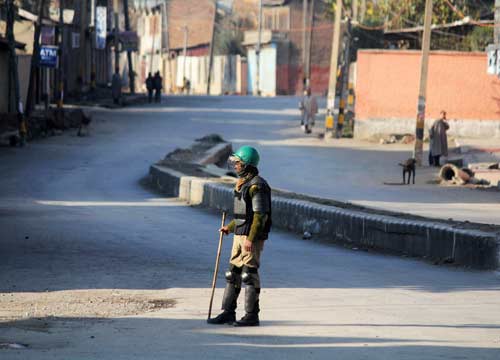IBNE MUHAMMAD
Azhar is a star stone-pelter. A committed protester who, alongside his comrades, has been giving tough time to law enforcing agencies in the lanes of downtown Srinagar, especially during the last three consecutive summer agitations in 2008, ’09 and ‘10. The heavy troop deployment does not scare him; rather it excites him and curfew, howsoever hard it may be, fails to chain his spirits.
Azhar wants to keep his spirit and his stones ‘until his freedom come’. However, the recent clampdown on Hawal, Zadibal and the adjoining areas proved a dampener to the hardcore. He compromised. For the first time perhaps in the last five years, he thought of restrictions as “protection.”
“I hate them (khakis) but this time I think it is the only way to protect people.” Protect whom from whom? Ask him and he first chuckles, hesitates and then a thoughtful but visibly worried look appears on his face.
Had it been a regular protest against the state, Azhar would have been on the frontline but this time, the skirmish had loud sectarian overtones. It broke his heart as it divided his friends across the line. Comrades turned rivals. Targets changed. Hands, even the stones were divided. Azhar and his friends were on the spot when situation took an ugly turn. But nobody has the exact clue about what led to the scene.
“A group of youth was protesting against the shoe controversy and wanted to enforce strike. They had an argument with some people present in the Hawal Chowk. Amid this hue and cry, a stone hit a Muharram banner hanged in the chowk and all of a sudden, a commotion erupted. People starting shouting and in no time stone pelting started” Azhar said.
The brawl continued for almost an hour during which some houses and shops were damaged. When the situation started worsening, the authorities imposed a curfew. Status quo continued for seven long days with brief intervals of reported attempts to attack the houses of a particular community.
Clashes around ashura are not entirely new to Hawal chowk. Even before militancy erupted in Kashmir valley, such incidents have happened in the area. Although during the peak years of militancy the sectarian schism took a dip, but from the last five years, the distasteful clashes have resurfaced. However, the local opinion is divided on classifying the brawl as out and out sectarian.
“We have a huge population belonging to both the sects living around, say from Nowshera side. The clashes never happen from that side. If it was about sectarian issues, are the people of both the sects living there less religious than this side?” Mohammad Shafi, a local shop keeper said. He believes that there are some “miscreants” who have marked a spot where they gather at the time of Muharram to incite trouble.
Imran, a local resident in his early 30’s seconds Shafi. “I know many boys from the other side. We usually spent our evenings together tasting the delicious seekh-tuj from local vendors. They are also clueless about these miscreants. The local population is taken hostage by these rogue elements and we don’t know on whose behest they are working.”
Earlier, the J&K police would use force to quell such clashes or they would impose milder restrictions to keep the miscreants away. But this time, the whole area was put under a week-long siege. Life inside the area was brought to a standstill when barely a kilometer or so away it was going on in full gear. After the curfew was lifted, the situation instantly leaped to normalcy. The deserted Hawal–Alamgaribazar road was in no time filled with traffic and people, as if doubting their legs, were strolling up and down the road. Was the prolonged curfew an effective strategy? Seemingly, it worked.
However, the vox pop has a mixed opinion, with mostly critical voices. A passerby questioned the rationality of prolonging the siege and wanted civil administration to play a role. “I agree the instant curfew was a must to bring some order to the chaotic environs but once this goal was achieved, the civil administration could have stepped in and used its rapport to bring the saner elements together and create an opportunity to talk.”
Imran, once again, was in agreement. “Why can’t we have any alternative to prolonged curfews as during any siege, rumors grow and lead to further chaos,” he said. “Civil administration could have definitely played a role in bringing the calm sooner by involving citizens from both sides in joint talks and dispel any doubts or misunderstandings if at all there existed any,” he added.
Azhar took no part in this debate. For him, the siege ended at a good note. As it was separatists who made a breakthrough by organizing a “unity march,” Azhar considers it a victory of the sentiment. He sees a ray of hope in this. “Ultimately it is the sentiment which can become a binding force provided we are ready to adopt the ways to take everybody along.”
The names of some people have been changed on request.
















